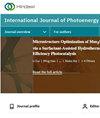用荠菜叶提取物合成TiO2纳米粒子及其光催化评价和杀微生物效果
IF 2.1
4区 工程技术
Q3 CHEMISTRY, PHYSICAL
引用次数: 2
摘要
在本研究中,对钛纳米颗粒(TiO2 NPs)的光催化活性和杀菌活性进行了评价。TiO2 NPs采用植物合成工艺,原料为棘叶提取物。为了确定粒径是否能提高光催化和杀微生物活性,将光合产物的pH分别修饰为12、7和4。利用紫外可见光谱(UV-Vis)、傅里叶红外光谱(FT-IR)和高分辨率透射电镜(HR-TEM)对修饰后的TiO2 NPs进行了表征,揭示了植物合成的TiO2 NPs的晶体和形态特征。紫外可见光谱分析显示TiO2 NPs的波长为327 nm,而FT-IR则证实TiO2 NPs存在于536 ~ 532 cm-1之间。最后,hrtem分析表明,所有纳米颗粒均具有TiO2组成,粒径范围在25 ~ 35 nm之间。在光催化和杀微生物实验中,采用了3种浓度的TiO2纳米粒子(100、50和10 mg/L),结果表明,当TiO2纳米粒子浓度为10 mg·L-1时,TiO2纳米粒子对光降解苯酚(10 mg·L-1)的光催化活性高达98.7%,当TiO2纳米粒子浓度为100 mg·L-1时,其对金黄色葡萄球菌的杀微生物活性高于对大肠杆菌的杀微生物活性。本文章由计算机程序翻译,如有差异,请以英文原文为准。
Phytosynthesis of TiO2 Nanoparticles Using E. crassipes Leaf Extracts, Their Photocatalytic Evaluation and Microbicide Effect
In the present research work, the photocatalytic and microbicidal activities of titanium nanoparticles (TiO2 NPs) were evaluated. TiO2 NPs were obtained through the phytosynthesis process, using Eichhornia crassipes leaf extract. In order to determine whether particle size improves photocatalytic and microbicidal activities, the pH of the photosynthesized was modified to 12, 7, and 4. The TiO2 NPs modified were characterized by UV-Vis spectroscopy (UV-Vis), Fourier transform infrared spectroscopy (FT-IR), and high-resolution transmission electron microscopy (HR-TEM) to reveal the crystalline and morphological nature of the phytosynthesized TiO2 NPs. UV-Vis analysis revealed that the wavelength for the TiO2 NPs was 327 nm, while FT-IR confirmed the presence of TiO2 NPs at peaks located between 536 and 532 cm-1. Finally, HR-TEM analysis showed that all nanoparticles had a TiO2 composition and a particle size ranging from 25 to 35 nm. For the photocatalytic and microbicidal tests, three concentrations of nanoparticles were used (100, 50, and 10 mg/L), and the results showed that TiO2 nanoparticles at a concentration of 10 mg·L-1 demonstrated excellent photocatalytic activity in photodegrading phenol [10 mg·L-1] up to 98.7%, while their microbicidal activity was more effective in contact with S. aureus than with E. coli, using a TiO2 NPs concentration of 100 mg·L-1.
求助全文
通过发布文献求助,成功后即可免费获取论文全文。
去求助
来源期刊
CiteScore
6.00
自引率
3.10%
发文量
128
审稿时长
3.6 months
期刊介绍:
International Journal of Photoenergy is a peer-reviewed, open access journal that publishes original research articles as well as review articles in all areas of photoenergy. The journal consolidates research activities in photochemistry and solar energy utilization into a single and unique forum for discussing and sharing knowledge.
The journal covers the following topics and applications:
- Photocatalysis
- Photostability and Toxicity of Drugs and UV-Photoprotection
- Solar Energy
- Artificial Light Harvesting Systems
- Photomedicine
- Photo Nanosystems
- Nano Tools for Solar Energy and Photochemistry
- Solar Chemistry
- Photochromism
- Organic Light-Emitting Diodes
- PV Systems
- Nano Structured Solar Cells

 求助内容:
求助内容: 应助结果提醒方式:
应助结果提醒方式:


